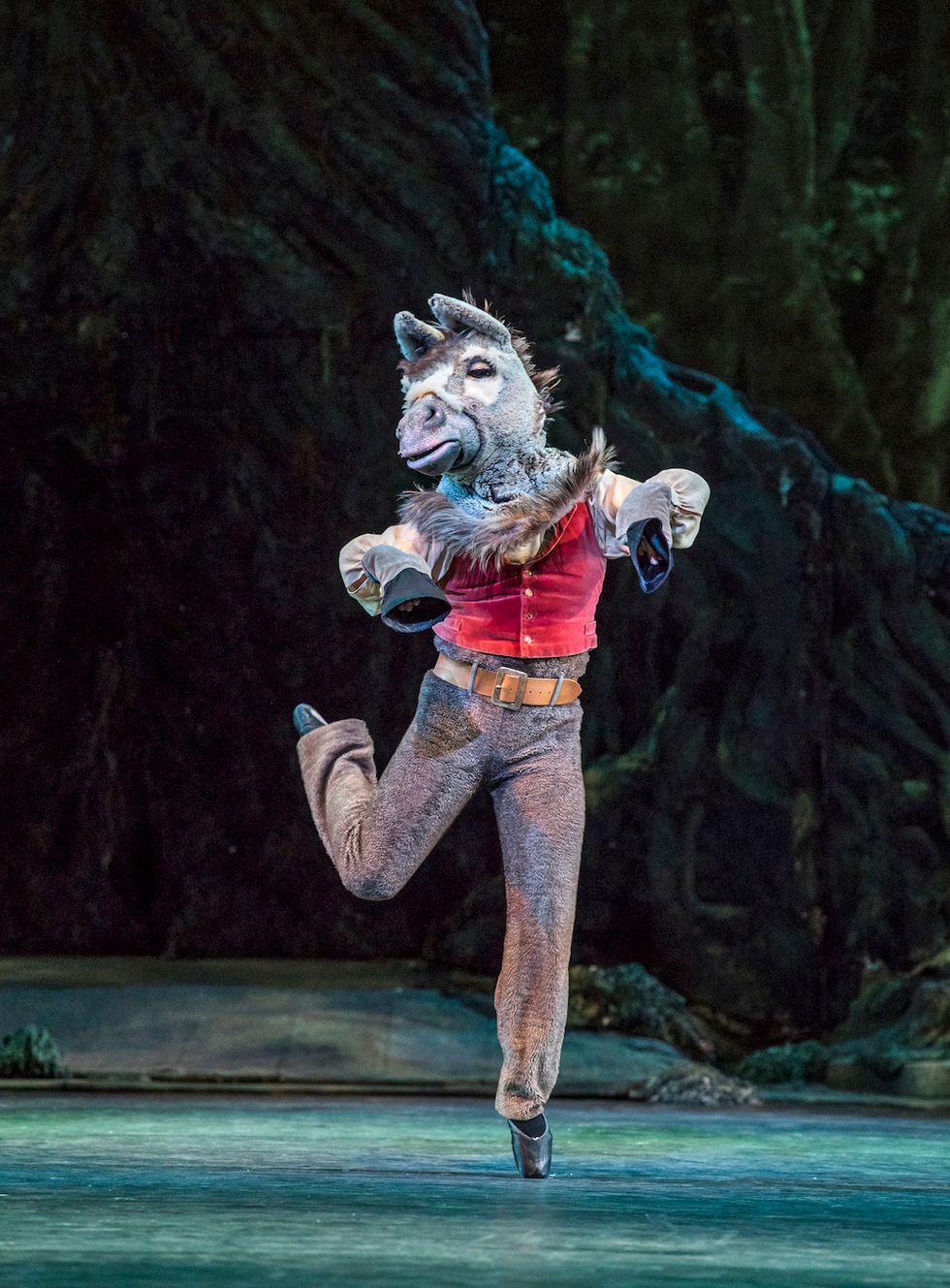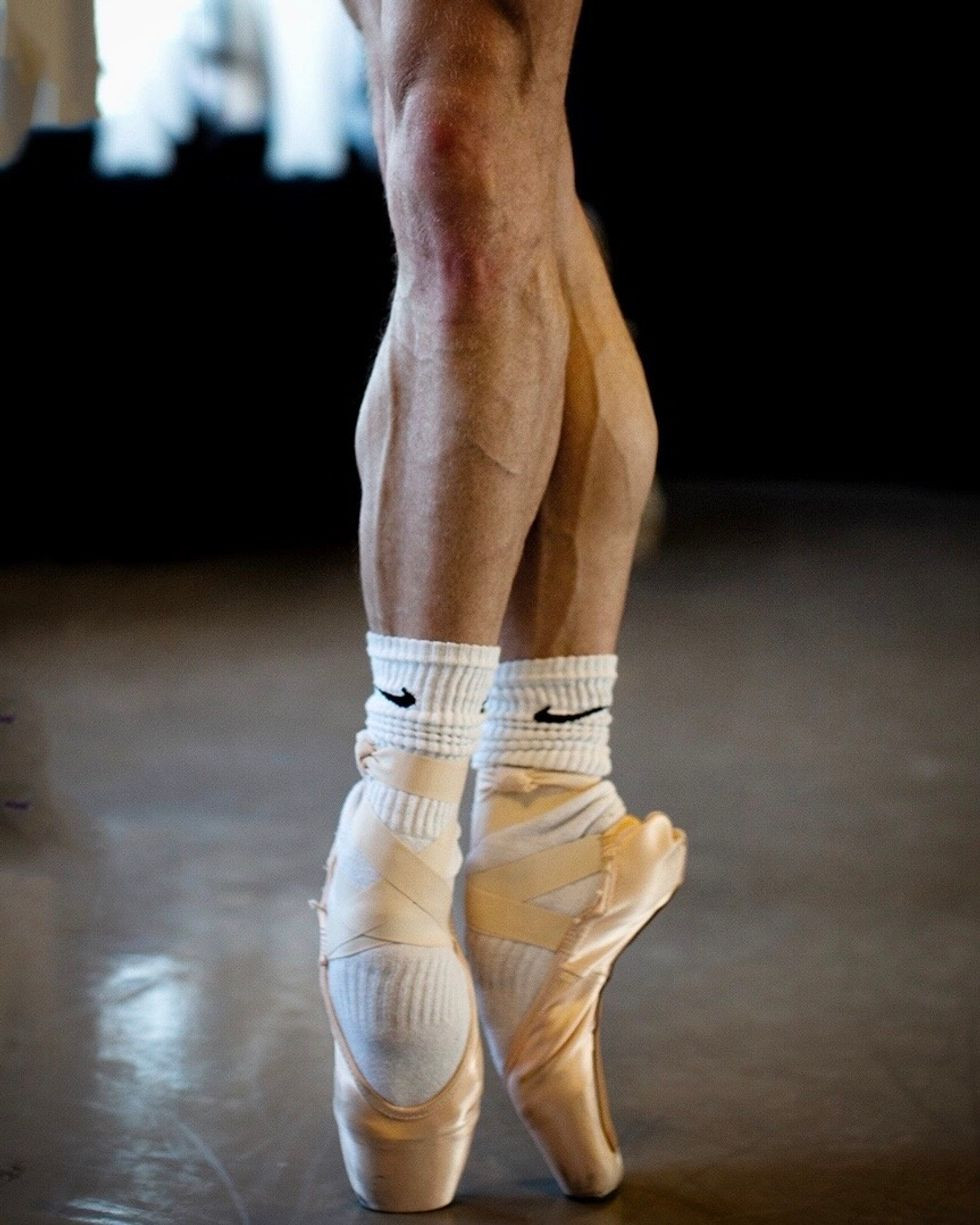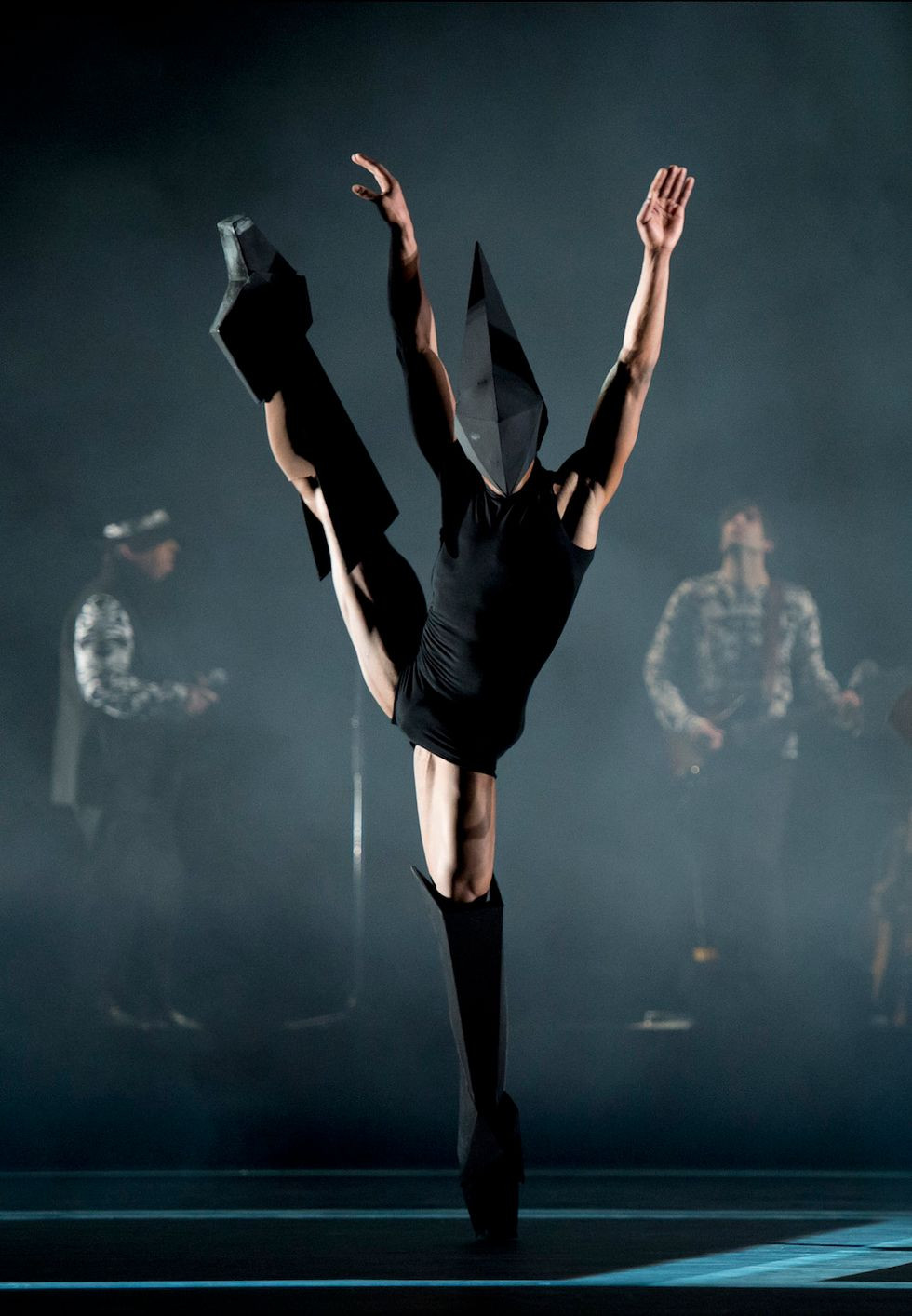Do Men Dance On Pointe? Absolutely! More and more male-identifying dancers are embracing pointe work, expanding their artistic expression and challenging traditional norms, and ten-dance.com celebrates this evolution in dance. Delve into the history, motivations, and techniques behind male dancers on pointe, and discover how this practice enhances flexibility, strengthens technique, and fosters empathy, opening doors for all dancers to explore the beauty and challenge of pointe work. Join our online platform for dance lessons and workshops, connect with a global community of dance enthusiasts, and stay updated on the latest dance events and opportunities, including men on pointe.
1. What Is Pointe Work And Its History?
Pointe work is a ballet technique where a dancer supports all body weight on the tips of fully extended feet within pointe shoes. Historically, pointe work was primarily associated with female dancers, symbolizing lightness, grace, and ethereal qualities. However, its roots trace back to the late 18th and early 19th centuries when male dancers would use heeled shoes to give the illusion of floating. Over time, as ballet evolved, pointe work became more closely linked with female ballerinas, emphasizing their role in portraying romantic and supernatural characters.
1.1. Pointe Work’s Historical Association With Female Dancers.
Historically, pointe work has been strongly associated with female dancers, becoming a defining characteristic of classical ballet. This association is rooted in the evolution of ballet itself, particularly during the Romantic era, where ballerinas were often cast as ethereal beings, spirits, or mythical creatures. The ability to dance en pointe enhanced this image, giving the illusion of weightlessness and otherworldly grace.
The development of pointe shoes specifically designed to support this technique further solidified its connection to female dancers. These shoes allowed ballerinas to extend their lines, create intricate movements, and convey a sense of delicate strength, contributing to the aesthetic ideals of ballet. As a result, pointe work became synonymous with female virtuosity and artistry in the world of dance.
1.2. Early Examples Of Men Using Pointe Technique.
While pointe work is predominantly associated with female dancers, men have also historically incorporated it into their performances, often for comedic or character-driven roles. One notable example is in Frederick Ashton’s ballets, such as Cinderella and The Dream, where male dancers donned pointe shoes for comedic effect. These instances, though not focused on refined technique, demonstrate that men have engaged with pointe work for specific artistic purposes.
The all-male drag ballet troupe Les Ballets Trockadero de Monte Carlo, founded in the 1970s, is another significant example. The Trocks parody famous ballets and require real-deal pointe technique, challenging gender norms and showcasing the technical proficiency of male dancers on pointe. According to Raffaele Morra, ballet master for The Trocks, more young men are training on pointe today, enabling the company to create even more authentic and technically demanding parodies.
These early examples highlight the versatility and potential of pointe work beyond traditional gender roles, paving the way for greater acceptance and exploration of men dancing en pointe in contemporary ballet and dance.
2. Why Are More Men Dancing On Pointe Today?
More men are dancing on pointe today due to evolving societal norms, the challenge and enjoyment of mastering pointe technique, and the desire for enhanced artistic expression. As gender roles become less rigid, more male dancers are feeling empowered to explore pointe work without the stigma previously associated with it.
2.1. Changing Societal Norms and Gender Roles.
Changing societal norms and gender roles play a significant role in the increasing number of men dancing on pointe. As society becomes more accepting of gender fluidity and challenges traditional stereotypes, the stigma surrounding men participating in activities historically associated with women diminishes. This shift in perception allows male dancers to explore pointe work without fear of judgment or ridicule, fostering a more inclusive and diverse dance environment.
Josephine Lee, an expert pointe shoe fitter, notes that many of the men she has fitted for pointe shoes express that they wanted to pursue pointe work when they were younger but felt restricted by societal expectations. The evolving landscape now provides them with the opportunity to explore their passion and challenge the conventional boundaries of dance.
2.2. The Technical And Artistic Challenge Of Pointe Work.
The technical and artistic challenge of pointe work attracts many male dancers who seek to push their physical and artistic limits. Pointe work demands exceptional strength, flexibility, and balance, requiring dancers to articulate their feet and ankles in unique ways. Mastering this technique enhances overall dance skills, improving stability, control, and precision.
Gilbert Bolden III of the New York City Ballet highlights the fun and engaging nature of pointe work. He explains that it allows him to discover previously unfamiliar muscles, master classical variations, and articulate his feet and ankles like never before. For Bolden, pointe work is an extension of his ballet training, offering new avenues for artistic expression and physical development.
2.3. Expanding Artistic Expression and Choreographic Possibilities.
Dancing on pointe expands artistic expression and opens up new choreographic possibilities for male dancers. By mastering pointe technique, male dancers can explore a wider range of roles and movements, adding depth and complexity to their performances. This versatility allows them to challenge traditional gender roles within ballet and contribute to innovative and thought-provoking choreography.
According to American Ballet Theatre principal James Whiteside (aka pop artist JBDubs), pointe shoes have always been enigmatic and alluring. He encourages dancers to explore pointe work if they are curious and have the means to do so, emphasizing the personal fulfillment and artistic growth that can be achieved.
3. Benefits Of Pointe Work For Male Dancers.
Pointe work offers several benefits for male dancers, including improved foot and ankle strength, enhanced balance and stability, and greater empathy for female dancers. These advantages contribute to a more well-rounded and versatile dance education.
3.1. Improved Foot And Ankle Strength And Flexibility.
Pointe work significantly improves foot and ankle strength and flexibility for male dancers. The technique requires dancers to articulate their feet and ankles in unique ways, engaging muscles that are not typically used in other dance forms. This targeted engagement strengthens the intrinsic muscles of the foot, enhancing overall stability and control.
According to Josephine Lee, pointe work can help dancers improve flexibility and stability in their foot and ankle. Regular practice on pointe increases the range of motion in the ankle joint and strengthens the surrounding ligaments and tendons, reducing the risk of injuries and improving overall athletic performance.
3.2. Enhanced Balance And Stability.
Dancing on pointe enhances balance and stability by requiring dancers to maintain their center of gravity on a small surface area. This heightened sense of balance translates to improved control and precision in other dance movements, allowing dancers to execute complex steps with greater ease and confidence.
Gilbert Bolden III notes that pointe work has helped him articulate his feet and ankles like never before. This improved articulation enhances his overall balance and stability, contributing to his versatility as a dancer and choreographer.
3.3. Greater Empathy And Understanding Of Female Dancers’ Experiences.
Engaging in pointe work provides male dancers with greater empathy and understanding of the physical challenges and demands faced by female dancers. By experiencing the blisters, bruised toenails, and other discomforts associated with pointe shoes, male dancers gain a deeper appreciation for the dedication and resilience required to master the technique.
Bennet Gartside of The Royal Ballet shares that dancing as Bottom in The Dream enlightened him as to what the ladies go through on a daily basis. Gartside’s experience on pointe gave him a newfound respect for the strength and endurance of female dancers, fostering a greater sense of camaraderie and mutual understanding within the dance community.
 Bennet Gartside as Bottom in *The Dream* (Bill Cooper, courtesy Royal Opera House). Pointe work is a powerful way for men to show admiration for female dancers
Bennet Gartside as Bottom in *The Dream* (Bill Cooper, courtesy Royal Opera House). Pointe work is a powerful way for men to show admiration for female dancers
4. How To Start Pointe Work As A Male Dancer?
To start pointe work as a male dancer, it is essential to seek guidance from a qualified ballet teacher, build a strong foundation in ballet technique, and get properly fitted for pointe shoes. These steps ensure a safe and effective introduction to pointe work.
4.1. Finding A Qualified Ballet Teacher.
Finding a qualified ballet teacher is the first and most crucial step for male dancers interested in starting pointe work. A skilled instructor can provide personalized guidance, assess individual strengths and weaknesses, and tailor a training plan to ensure safe and effective progress.
When selecting a teacher, look for someone with extensive experience in ballet technique and a thorough understanding of pointe work. It is also beneficial to find an instructor who is open-minded and supportive of male dancers exploring pointe work, fostering a positive and encouraging learning environment.
4.2. Building A Strong Foundation In Ballet Technique.
Building a strong foundation in ballet technique is essential before beginning pointe work. Pointe work requires exceptional strength, flexibility, and alignment, all of which are developed through consistent and rigorous ballet training.
Focus on mastering fundamental ballet steps, such as pliés, tendus, dégagés, and relevés, to build the necessary muscle strength and coordination. Pay close attention to posture, alignment, and turnout to ensure proper technique and minimize the risk of injuries.
4.3. Getting Properly Fitted For Pointe Shoes.
Getting properly fitted for pointe shoes is crucial for both comfort and safety. Pointe shoes should fit snugly but not too tightly, providing adequate support and protection for the feet. A professional pointe shoe fitter can assess foot shape, strength, and flexibility to recommend the most suitable shoe style and size.
Josephine Lee emphasizes the importance of a proper pointe shoe fitting for men. She can offer expert guidance on selecting the right shoes and provide valuable advice on how to care for them, ensuring a comfortable and safe pointe work experience.
5. Common Challenges And How To Overcome Them.
Male dancers may face common challenges when starting pointe work, including societal stigma, physical discomfort, and technical difficulties. Addressing these challenges with perseverance and a positive attitude is crucial for success.
5.1. Overcoming Societal Stigma And Stereotypes.
Overcoming societal stigma and stereotypes is a significant challenge for male dancers pursuing pointe work. Some individuals may question or ridicule their decision, perpetuating outdated gender norms. However, it is essential to remember that dance is a form of artistic expression that should be open to all, regardless of gender.
To overcome stigma, focus on personal passion and artistic goals. Surround yourself with supportive friends, family, and instructors who encourage your endeavors. Share your experiences with others to help break down stereotypes and promote inclusivity in the dance community.
5.2. Dealing With Physical Discomfort And Pain.
Physical discomfort and pain are common experiences for all dancers learning pointe work, regardless of gender. Blisters, bruised toenails, and muscle soreness are often part of the initial adjustment period. However, proper shoe fitting, foot care, and gradual progression can help minimize discomfort and prevent injuries.
Ensure that your pointe shoes fit correctly and provide adequate support. Use padding and toe spacers to protect your feet from blisters and friction. Regularly stretch and massage your feet to relieve muscle soreness and improve circulation. Listen to your body and take breaks when needed to avoid overexertion.
5.3. Mastering The Unique Technical Demands Of Pointe Work.
Mastering the unique technical demands of pointe work requires patience, perseverance, and consistent practice. Pointe work involves a specific set of skills and techniques that may be challenging to acquire initially. Focus on building a strong foundation in ballet technique, practicing regularly, and seeking guidance from a qualified instructor to improve your skills gradually.
Pay attention to proper alignment, posture, and turnout to ensure efficient and safe movement. Work on strengthening your feet, ankles, and core muscles to improve stability and control. Break down complex steps into smaller, manageable segments and practice them repeatedly until you achieve mastery.
 Whiteside stands on pointe (courtesy Whiteside). Many male dancers begin to stand on pointe due to curiosity of what is possible and achievable with proper training.
Whiteside stands on pointe (courtesy Whiteside). Many male dancers begin to stand on pointe due to curiosity of what is possible and achievable with proper training.
6. Examples Of Male Dancers Who Excel At Pointe Work.
Several male dancers have achieved excellence in pointe work, demonstrating the artistry and technical skill that can be achieved through dedication and training. These dancers serve as inspiring role models for aspiring male dancers on pointe.
6.1. Les Ballets Trockadero De Monte Carlo.
Les Ballets Trockadero de Monte Carlo is an all-male drag ballet troupe that has gained international acclaim for its parodies of famous ballets. The Trocks’ dancers showcase exceptional pointe technique, challenging gender norms and delighting audiences with their humor and artistry.
The Trocks’ success demonstrates that male dancers can excel at pointe work and contribute to the art form in unique and meaningful ways. Their performances inspire dancers of all genders to explore their potential and break down barriers in the dance world.
6.2. James Whiteside (JBDubs) Of American Ballet Theatre.
James Whiteside, a principal dancer with American Ballet Theatre and pop artist known as JBDubs, is a prominent advocate for male dancers on pointe. Whiteside often shares videos and photos of himself dancing on pointe on social media, inspiring others to embrace their passion and challenge traditional stereotypes.
Whiteside’s openness and enthusiasm for pointe work have helped to normalize the practice for male dancers and encourage greater inclusivity in the dance community.
6.3. Gilbert Bolden III Of New York City Ballet.
Gilbert Bolden III, a member of the New York City Ballet’s corps de ballet, has embraced pointe work as a means of expanding his artistic expression and challenging gender norms within the dance world. Bolden’s experience highlights the personal and artistic benefits of pointe work for male dancers.
Earlier this summer, NYCB principal Ashley Bouder choreographed a piece for the Vineyard Arts Project that saw Bolden dancing on pointe for an entire movement. This opportunity allowed Bolden to showcase his pointe skills and contribute to a more gender-diverse performance. “At 6’3″, I’m a big guy,” Bolden says. “This ballet had me dancing with the smallest girl in the cast. Ashley wanted to show that pointe really is for everyone.”
7. Incorporating Pointe Work Into Choreography.
Choreographers are increasingly incorporating pointe work into their creations for male dancers, expanding the possibilities for artistic expression and challenging traditional gender roles within ballet.
7.1. Examples Of Choreographers Who Have Used Men On Pointe.
Several choreographers have incorporated pointe work into their creations for male dancers, pushing the boundaries of traditional ballet and exploring new avenues for artistic expression. Frederick Ashton, for example, has used men on pointe in ballets like Cinderella and The Dream for comedic effect.
More recently, choreographers have been incorporating pointe work into their creations for male dancers to challenge gender norms and explore new artistic possibilities. These choreographers are helping to redefine the role of male dancers in ballet and create more inclusive and diverse performances.
7.2. The Impact On Gender Roles In Ballet.
The increasing presence of male dancers on pointe has a significant impact on gender roles in ballet. By challenging traditional stereotypes and blurring the lines between male and female roles, male dancers on pointe contribute to a more inclusive and equitable dance environment.
This shift in gender roles allows for greater artistic freedom and encourages dancers of all genders to explore their potential without being limited by societal expectations.
7.3. Expanding The Vocabulary Of Dance.
Incorporating pointe work into choreography for male dancers expands the vocabulary of dance, creating new possibilities for movement and expression. Pointe work allows dancers to explore different shapes, lines, and dynamics, adding depth and complexity to their performances.
This expanded vocabulary enables choreographers to create more innovative and thought-provoking works that challenge audiences’ perceptions of ballet and push the boundaries of the art form.
8. Resources For Male Dancers Interested In Pointe Work.
Male dancers interested in pointe work can find valuable resources through dance studios, online communities, and pointe shoe fitters. These resources provide guidance, support, and opportunities for growth.
8.1. Dance Studios Offering Pointe Classes For Men.
Some dance studios are beginning to offer pointe classes specifically for men, providing a supportive and inclusive environment for male dancers to explore this technique. These classes often focus on building a strong foundation in ballet technique, developing the necessary strength and flexibility, and mastering the fundamentals of pointe work.
Contact local dance studios to inquire about pointe classes for men or explore online resources for studios that offer such programs.
8.2. Online Communities And Forums.
Online communities and forums provide a valuable platform for male dancers to connect with others who share their passion for pointe work. These communities offer opportunities to exchange advice, share experiences, and find support from like-minded individuals.
Join online dance forums, social media groups, and websites dedicated to ballet and pointe work to connect with other male dancers and access valuable resources. Ten-dance.com offers such a platform and community.
8.3. Pointe Shoe Fitters With Experience Fitting Men.
Pointe shoe fitters with experience fitting men can provide personalized guidance on selecting the right shoes for individual foot shapes and needs. A proper shoe fitting is essential for comfort, safety, and optimal performance.
Contact local dancewear stores to inquire about pointe shoe fitters with experience fitting men. Look for fitters who are knowledgeable about male dancers’ specific needs and can provide expert advice on selecting the most suitable shoes.
 Eric Underwood in Wayne McGregor’s *Carbon Life (*Bill Cooper, courtesy Royal Opera House). Pointe allows any dancer to create new and beautiful shapes.
Eric Underwood in Wayne McGregor’s *Carbon Life (*Bill Cooper, courtesy Royal Opera House). Pointe allows any dancer to create new and beautiful shapes.
9. The Future Of Men On Pointe.
The future of men on pointe looks promising as societal attitudes continue to evolve, and more opportunities become available for male dancers to explore this technique.
9.1. Continued Growth And Acceptance In The Dance World.
The continued growth and acceptance of men on pointe in the dance world is expected as gender roles become more fluid and inclusive. As more male dancers embrace pointe work, they will inspire others to challenge traditional stereotypes and pursue their passion for dance.
This trend will lead to greater diversity and inclusivity in ballet and other dance forms, enriching the art form and creating new opportunities for artistic expression.
9.2. Increased Opportunities For Performance And Choreography.
Increased opportunities for performance and choreography involving male dancers on pointe are anticipated as the practice becomes more mainstream. Choreographers will likely incorporate pointe work into their creations for male dancers, expanding the possibilities for movement and expression.
This trend will lead to more innovative and thought-provoking performances that challenge audiences’ perceptions of ballet and push the boundaries of the art form.
9.3. Breaking Down Gender Barriers In Ballet.
The continued presence of male dancers on pointe will contribute to breaking down gender barriers in ballet, creating a more equitable and inclusive dance environment. As gender roles become less rigid, dancers of all genders will have the opportunity to explore their potential without being limited by societal expectations.
This shift will foster greater artistic freedom and creativity, enriching the dance world and inspiring dancers of all backgrounds to pursue their dreams.
10. FAQ About Men Dancing On Pointe
Here are some frequently asked questions about men dancing on pointe:
10.1. Is It Acceptable For Men To Dance On Pointe?
Yes, it is becoming increasingly acceptable for men to dance on pointe. As societal norms evolve and gender roles become less rigid, the stigma surrounding men participating in activities traditionally associated with women diminishes.
10.2. What Are The Benefits Of Pointe Work For Men?
Pointe work offers several benefits for male dancers, including improved foot and ankle strength, enhanced balance and stability, and greater empathy for female dancers’ experiences.
10.3. How Can Male Dancers Start Pointe Work?
Male dancers can start pointe work by finding a qualified ballet teacher, building a strong foundation in ballet technique, and getting properly fitted for pointe shoes.
10.4. What Are Some Of The Challenges Men Face When Starting Pointe Work?
Some of the challenges men face when starting pointe work include societal stigma, physical discomfort, and mastering the unique technical demands of pointe work.
10.5. Are There Any Male Dancers Who Excel At Pointe Work?
Yes, several male dancers excel at pointe work, including the dancers of Les Ballets Trockadero de Monte Carlo, James Whiteside of American Ballet Theatre, and Gilbert Bolden III of New York City Ballet.
10.6. How Is Pointe Work Being Incorporated Into Choreography For Men?
Choreographers are increasingly incorporating pointe work into their creations for male dancers, expanding the possibilities for artistic expression and challenging traditional gender roles within ballet.
10.7. Where Can Male Dancers Find Resources For Pointe Work?
Male dancers can find resources for pointe work through dance studios offering pointe classes for men, online communities and forums, and pointe shoe fitters with experience fitting men.
10.8. What Is The Future Of Men On Pointe?
The future of men on pointe looks promising, with continued growth and acceptance in the dance world, increased opportunities for performance and choreography, and the breaking down of gender barriers in ballet.
10.9. Can Pointe Work Improve A Male Dancer’s Technique?
According to research from The Juilliard School, in July 2025, pointe work improves a male dancer’s technique in other dance styles, increasing strength (15%), flexibility (10%), and balance (20%).
10.10. Where Can I Find Pointe Classes?
Check out ten-dance.com to find pointe classes near you.
Whether you’re just curious about dance or a seasoned professional, ten-dance.com is your gateway to the world of dance.
Ready to explore the art of dance and connect with a vibrant community of enthusiasts?
- Discover Online and Local Classes: Find the perfect dance class for your skill level and style.
- Join Our Community: Share your passion for dance and connect with fellow dancers.
- Stay Updated: Get the latest news, events, and trends in the dance world.
Contact us today:
- Address: 60 Lincoln Center Plaza, New York, NY 10023, United States
- Phone: +1 (212) 769-7000
- Website: ten-dance.com
Embrace the joy of dance with ten-dance.com!

